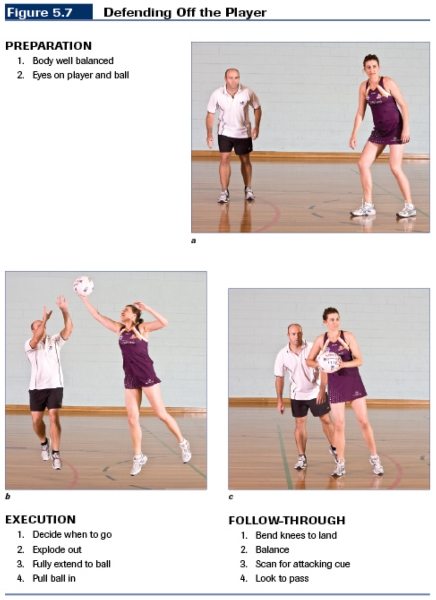Defending in netball is a challenge
This is an excerpt from Netball: Steps to Success - 2nd Edition by Wilma Shakespear & Margaret Caldow.
Defending Off the Player
The aim of defending off the player is to gain possession of the ball from the attacking team through an interception. While defending off a player, you are aware of your opponent's movements, but the ball is the focus of your attention. Position yourself so you can drive hard to cut off an incoming pass. The element of surprise that such defence brings is a strength. Attackers become uncertain, which can increase their error rate.
Watch the player and the ball closely as they travel down court. Judge the speed of the ball and the distance it is travelling. Remember that the long high ball gives you the best chance to cover ground. Decide which ball to intercept. Attack the ball and take the pass at full extension (figure 5.7).

Defence Drills
Defending requires you to make decisions about your move, your opponent's move and the pass that is coming in. Drills need to focus on these aspects. You will notice that the drills in this section are done in small groups; it is very difficult to practise defending by yourself.
Defence Drill 1. Shadowing
You are the defender, and your partner is the attacker. Take a starting position for one-on-one defence. Call "Go". When the attacker moves, you must stay close for 3 seconds. Work hard to shadow every move.
To Increase Difficulty
- Change your starting position to the opposite side, to the back and finally to the front. Have a player stand out in front of you with the ball. Now keep both your partner and the ball in view while you work. Work all positions.
- When you can stay close for 3 seconds from these positions, have the player with the ball pass to your partner. Try to deflect or intercept the pass. If you are beaten, quickly recover and pressure the pass.
- The thrower now gives your partner three consecutive passes. Stick tight to your partner and see how many times you can take the ball or cause the attackers to make an error.
Success Check
- Body well balanced.
- Weight down.
- Eyes on the opponent and the ball.
- Feet shoulder-width apart.
- Arms close to the body.
- Quick feet and recovery.
Score Your Success
Stay close to the attacker for 3 seconds by using good one-on-one defence = 10 points
Your score ___
Defence Drill 2. Line Defence
Three attackers and three defenders stand in a line facing the feeder, who has the ball. The defenders wear bibs to distinguish them from the attackers. The first attacker prepares to offer. The first defender takes up a good starting position to force the attacker wide. The attacker offers and the defender reacts to the move. The defender tries to intercept the pass from the feeder.
The successful player returns the ball to the feeder. As the ball is returning to the feeder, the next attacker and defender start the drill. After the defenders are able to successfully take three balls from the attackers, attackers and defenders change roles.
To Increase Difficulty
- Change the starting position of the defenders. Be sure you can keep the pressure on.
- Have each attacker try to take two consecutive passes. The defender must recover if beaten on the first ball and pressure the second move.
- Add three more pairs who stand beside the original players so there are two attacking lines about 3 metres apart. Both attackers offer, and both defenders work hard to push their attackers wide to cause an error or take an interception. Begin with each pair passing twice and build to five times. Vary the distance to the thrower and vary the distance between the attacking lines.
- Introduce a competitive element between attackers and defenders by allocating points for a successful pass for attackers and tips or intercepts by defenders. Challenge yourselves with drill variations.
Success Check
- Position well at the start.
- Force the attacker wide.
- Watch the player and the ball.
- Use quick feet.
- Attack the ball.
- Recover quickly.
Score Your Success
Defenders take 3 balls from the attackers = 10 points
Your score ___
More Excerpts From Netball: Steps to Success - 2nd Edition

Get the latest insights with regular newsletters, plus periodic product information and special insider offers.
JOIN NOW


